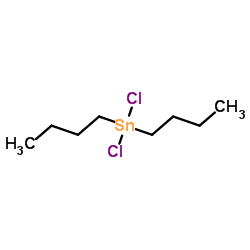dibutyldichlorotin

dibutyldichlorotin structure
|
Common Name | dibutyldichlorotin | ||
|---|---|---|---|---|
| CAS Number | 683-18-1 | Molecular Weight | 303.845 | |
| Density | 1.4 | Boiling Point | 275.3±0.0 °C at 760 mmHg | |
| Molecular Formula | C8H18Cl2Sn | Melting Point | 39 °C | |
| MSDS | Chinese USA | Flash Point | 107.8±18.7 °C | |
| Symbol |




GHS05, GHS06, GHS08, GHS09 |
Signal Word | Danger | |
|
Synthesis, characterization and biocidal activity of new organotin complexes of 2-(3-oxocyclohex-1-enyl)benzoic acid.
Eur. J. Med. Chem. 45 , 883-9, (2010) The reaction of 1,3-cyclohexadione with 2-aminobenzoic acid has produced the 2-(3-oxocyclohex-1-enyl)benzoic acid (HOBz). Subsequent reactions of the ligand with organotin chlorides led to [Me(2)Sn(OBz)O](2) (1), [Bu(2)Sn(OBz)O](2) (2), [Ph(2)Sn(OBz)O](2) (3)... |
|
|
Ascorbic acid alleviates pancreatic damage induced by dibutyltin dichloride (DBTC) in rats.
Yonsei Med. J. 48(6) , 1028-34, (2007) Because previous studies have reported depleted antioxidant capacity in patients with chronic pancreatitis (CP), prevention of free radical production has gained importance in antifibrotic treatment strategies for CP. The aim of this study was to investigate ... |
|
|
Gene expression profiling and endothelin in acute experimental pancreatitis.
World J. Gastroenterol. 18(32) , 4257-69, (2012) To analyze gene expression profiles in an experimental pancreatitis and provide functional reversal of hypersensitivity with candidate gene endothelin-1 antagonists.Dibutyltin dichloride (DBTC) is a chemical used as a polyvinyl carbonate stabilizer/catalyzer,... |
|
|
Analgesic effects of gabapentin on mechanical hypersensitivity in a rat model of chronic pancreatitis.
Brain Res. 1337 , 104-12, (2010) Gabapentin, an anticonvulsant, is widely accepted as an alternative therapeutic agent for neuropathic pain and has proved to produce analgesic effects in a mouse model of visceral pain. However, it is unknown whether gabapentin is also analgesically effective... |
|
|
Effect of taurine on acinar cell apoptosis and pancreatic fibrosis in dibutyltin dichloride-induced chronic pancreatitis.
Acta Med. Okayama 66(4) , 329-34, (2012) The relationship between pancreatic fibrosis and apoptosis of pancreatic acinar cells has not been fully elucidated. We reported that taurine had an anti-fibrotic effect in a dibutyltin dichloride (DBTC)-chronic pancreatitis model. However, the effect of taur... |
|
|
Modifications of erythrocyte membrane hydration induced by organic tin compounds.
Cell Biol. Int. 33(7) , 801-6, (2009) A study on the effects of selected organic chlorides of tin on the extent of hydration of the lipid bilayer of erythrocyte ghosts from pig blood is presented. The following compounds were used, dibutyltin dichloride (DBT), tributyltin chloride (TBT), diphenyl... |
|
|
Expression of transforming growth factor beta1/Sma- and Mad-related proteins in rat with chronic pancreatitis induced by dibutyltin dichloride.
Pancreas 39(2) , 252-3, (2010)
|
|
|
Bone marrow-derived pancreatic stellate cells in rats.
Cell Res. 20(3) , 288-98, (2010) Origin and fate of pancreatic stellate cells (PSCs) before, during and after pancreatic injury are a matter of debate. The crucial role of PSCs in the pathogenesis of pancreatic fibrosis is generally accepted. However, the turnover of the cells remains obscur... |
|
|
Solubilization of dibutyltin dichloride with surfactant solutions in single and mixed oil systems.
J. Hazard. Mater. 181(1-3) , 1109-14, (2010) The harmful effects of organometallic compounds and their metabolites on the environment and human health require the development of more effective remediation methods. Surfactant enhanced remediation has been considered as a potential method for the removal ... |
|
|
Effects of sensory denervation by neonatal capsaicin administration on experimental pancreatitis induced by dibutyltin dichloride.
Med. Mol. Morphol. 40(3) , 141-9, (2007) Increase in the number of intrapancreatic sensory nerve fibers has been implicated in the generation of pain in chronic pancreatitis. Because some sensory neurotransmitters (e.g., substance P) are known to have proinflammatory effects, we hypothesized that de... |